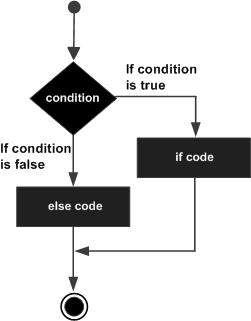if...else statement
if语句后面可以跟一个可选的else语句,该语句在布尔表达式为false时执行。
语法 (Syntax)
在R中创建if...else语句的基本语法是 -
if(boolean_expression) {
// statement(s) will execute if the boolean expression is true.
} else {
// statement(s) will execute if the boolean expression is false.
}
如果布尔表达式的计算结果为true ,则将执行if block代码if block ,否则将执行代码else block 。
流程图 (Flow Diagram)

例子 (Example)
x <- c("what","is","truth")
if("Truth" %in% x) {
print("Truth is found")
} else {
print("Truth is not found")
}
编译并执行上述代码时,会产生以下结果 -
[1] "Truth is not found"
这里“真理”和“真理”是两个不同的字符串。
if...else if...else (The if...else if...else Statement)
if语句后面可以跟一个else if...else语句,这对于使用单个if ... else if语句测试各种条件非常有用。
当使用if , else if , else语句时,要记住几点。
一个if可以有0或者else一个, if是的else ,它必须在else if之后。
if可以有零到多个,并且它们必须在else之前。
一旦else if成功, else if任何其他else if else不会被测试。
语法 (Syntax)
在R中创建if...else if...else语句的基本语法是 -
if(boolean_expression 1) {
// Executes when the boolean expression 1 is true.
} else if( boolean_expression 2) {
// Executes when the boolean expression 2 is true.
} else if( boolean_expression 3) {
// Executes when the boolean expression 3 is true.
} else {
// executes when none of the above condition is true.
}
例子 (Example)
x <- c("what","is","truth")
if("Truth" %in% x) {
print("Truth is found the first time")
} else if ("truth" %in% x) {
print("truth is found the second time")
} else {
print("No truth found")
}
编译并执行上述代码时,会产生以下结果 -
[1] "truth is found the second time"
